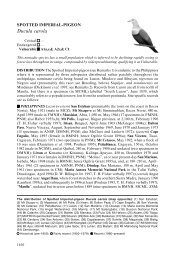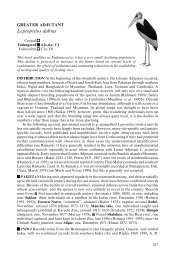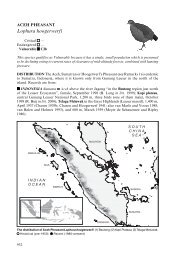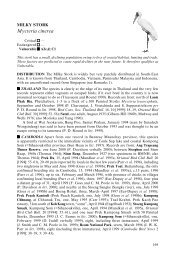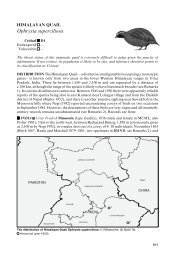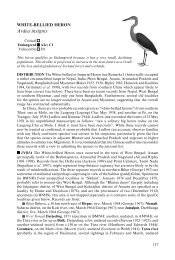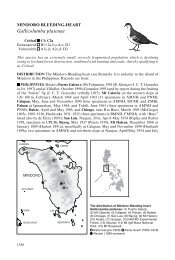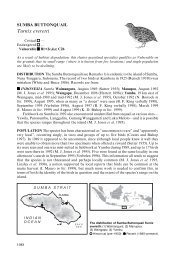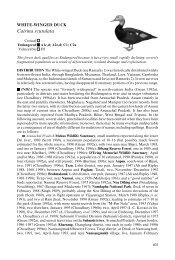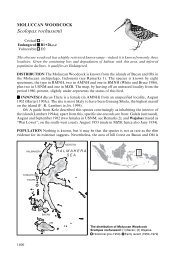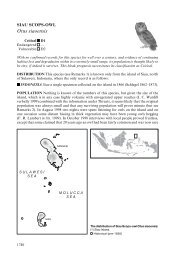Cacatua alba - BirdBase
Cacatua alba - BirdBase
Cacatua alba - BirdBase
Create successful ePaper yourself
Turn your PDF publications into a flip-book with our unique Google optimized e-Paper software.
WHITE COCKATOO<br />
<strong>Cacatua</strong> <strong>alba</strong><br />
Critical —<br />
Endangered —<br />
Vulnerable A2b,c,d<br />
This parrot has undergone an observed population decline, principally owing to unsustainable<br />
levels of exploitation for the cagebird trade. This is likely to increase in the near future, unless<br />
recently revised trapping quotas are effectively enforced, and it thus qualifies as Vulnerable.<br />
DISTRIBUTION The White Cockatoo has been listed as endemic to the islands of Halmahera,<br />
Bacan, Ternate, Tidore, Kasiruta and Mandiole in the North Moluccas, Indonesia, with<br />
records from Obi and its satellite Bisa considered to reflect introductions (White and Bruce<br />
1986, Lambert 1993a,b, Coates and Bishop 1997). In the absence of a clear record from<br />
Mandiole this locality is discounted here, although the species’s presence there is entirely<br />
plausible (the island is apparently still well forested: F. R. Lambert verbally 1999). On the<br />
other hand, its absence from Morotai appears to be real, and inexplicable (Smiet 1985),<br />
while the lack of records from the south-western and south-eastern arms of Halmahera may<br />
merely reflect a lack of visitors (MKP), although the south-western arm is composed largely<br />
of ultrabasic rock, so that the forest growing there is discouragingly dry and depauperate<br />
(K. D. Bishop in litt. 2000). Records are from:<br />
■ INDONESIA Halmahera Tobelo, undated (five specimens in RMNH); Labilabi, July 1998<br />
(I. Mauro in litt. 1999) and inland from Labilabi, February–March 1995 (Poulsen et al.<br />
1999); Akelamo, 1990 (K. D. Bishop per MKP) and Akelamo Kao (Lambert 1993a,b);<br />
Hilaitetor, December 1994 (Fuller undated); Sungai Ifis, 1994 (Fuller undated); Tolewang<br />
sago swamp, inland from Kao, April 1996 (Poulsen et al. 1999); Lolasita, March 1995 (BirdLife<br />
fide MKP); Peot, just to the south of Gunung Gamkonora, September 1983 (K. D. Bishop in<br />
M O L U C C A<br />
S E A<br />
42<br />
KASIRUTA<br />
ISLAND<br />
BACAN<br />
ISLAND<br />
MOROTAI<br />
ISLAND<br />
HALMAHERA<br />
ISLAND<br />
25<br />
28<br />
WEDA BAY<br />
24<br />
8<br />
13<br />
17<br />
39<br />
2<br />
6<br />
4<br />
5 7<br />
9 10<br />
14<br />
15<br />
18 12 19<br />
20<br />
16<br />
3<br />
11<br />
40<br />
41<br />
22<br />
21 23<br />
27 29<br />
26<br />
30<br />
32<br />
31<br />
35 34<br />
37<br />
38<br />
36<br />
1<br />
H A L M A H E R A<br />
S E A<br />
33<br />
The distribution of White Cockatoo <strong>Cacatua</strong> <strong>alba</strong>:<br />
(1) Tobelo; (2) Labilabi; (3) Akelamo; (4) Hilaitetor;<br />
(5) Sungai Ifis; (6) Tolewang; (7) Lolasita; (8) Peot;<br />
(9) Kao; (10) Dodaga; (11) Sungai Sosolat;<br />
(12) Gunung Subaim; (13) Jailolo; (14) Todowongi;<br />
(15) Miaf; (16) Jakarta Baru; (17) Matui; (18) Kali<br />
Batu Putih; (19) Buli; (20) Dodinga; (21) Sungai<br />
Oba; (22) Kulo; (23) Sagea; (24) Lelilef; (25) Hijrah;<br />
(26) Kobe; (27) Waleh; (28) Woda; (29) Dotte;<br />
(30) Weda; (31) Patani; (32) Tilope; (33) Gani;<br />
(34) Gorogoro; (35) Yaba; (36) Wayamega;<br />
(37) Sungai Ra; (38) Sawadai; (39) Danau Tolire<br />
Besar; (40) Gamalama; (41) Tidore; (42) Kasiruta.<br />
Historical (pre-1950) Fairly recent (1950–1979)<br />
Recent (1980–present) Undated<br />
1669
Threatened birds of Asia<br />
litt. 2000); Kao (or Kau), on the southern peninsula, undated (Salvadori 1880–1882) and on<br />
the Teluk Kao road, 1990s (K. D. Bishop in litt. 2000); Dodaga, April 1996 (MKP); Sungai<br />
Sosolat, east coast of Lalobata peninsula, March 1995 (MKP); Gunung Subaim, July/<br />
September 1994 (Fuller undated); Jailolo, undated (Salvadori 1880–1882), April 1931 (male<br />
in ZMB; see Remarks 1); Todowongi, February 1929 (specimen in IRSNB); inland from<br />
Miaf, April 1995 (Poulsen et al. 1999); Jakarta Baru, April 1995 (MKP); Matui, August and<br />
October 1996 (J. O. Gjershaug and N. Rov in litt. 1999); Kali Batu Putih (“Domato”) near<br />
Sidangoli, 1983–1999 (K. D. Bishop in litt. 2000), July 1987 (Lambert and Yong 1989) and<br />
subsequently (many observers in litt. 1999), including Telepeh, December 1995 (C. Donald<br />
in litt. 1999); inland from Buli, March–April 1995 (Poulsen et al. 1999), September 1996 (J. O.<br />
Gjershaug and N. Rov in litt. 1999); Dodinga, December 1874, January 1875 (Salvadori<br />
1880–1882; female in RMNH); Sungai Oba, August 1994 (Poulsen et al. 1999); inland from<br />
Kulo, July 1994 (Poulsen et al. 1999); Sagea, May 1999 (D. Agista in litt. 1999); Lelilef (Lelilef<br />
Waibulan), April 1999 (D. Agista in litt. 1999); Hijrah, May 1999 (D. Agista in litt. 1999);<br />
Kobe, May 1999 (D. Agista in litt. 1999); Waleh, May 1999 (D. Agista in litt. 1999); inland<br />
from Woda, June–July 1994 (Poulsen et al. 1999); Dotte, May 1999 (D. Agista in litt. 1999);<br />
Weda (as “Wedareise”), February 1894 (von Berlepsch 1903), July 1994 (SvB) and, at Tanjung<br />
Ulie and Gemaf, May 1999 (R. F. A. Grimmett verbally 1999), including “Nucifera”, May<br />
1949 (male in ZMA); Patani, January 1894 (von Berlepsch 1903); Tilope, 5 m, October 1950<br />
(female in ZMA); Gani, undated (Vorderman 1898b);<br />
Bacan many records in the nineteenth and early twentieth centuries (Guillemard 1885,<br />
Vorderman 1898b, specimens in AMNH, BMNH, RMNH); Gorogoro, October/November<br />
1991 (Lambert 1993a,b); Yaba, October/November 1991 (Lambert 1993a,b); Wayamega,<br />
October/November 1991 (Lambert 1993a,b); Sungai Ra, October/November 1991 (Lambert<br />
1993a,b); Sawadai, October/November 1991 (Lambert 1993a,b);<br />
Ternate unspecified localities, 1861–1862, 1871, March 1872, October 1875, August 1876,<br />
March 1880 (Salvadori 1880–1882, Pleske 1884, specimens in BMNH, MNHN, RMNH and<br />
SMF), 1980 (White and Bruce 1986); Danau Tolire Besar, September 1995 with 25 there in<br />
October 1996 (J. O. Gjershaug and N. Rov in litt. 1999), August 1998 (I. Mauro in litt. 1999),<br />
with 4–6 birds there (and apparently investigating a nest hole), May 1999 (R. F. A. Grimmett<br />
verbally 2000), and six birds during an hour-long visit, July 1999 (C. Bell in litt. 1999); base<br />
of Gamalama volcano, regularly in 1980s, although not clear if the birds involved were a<br />
natural population or escapes (Inskipp et al. 1988);<br />
Tidore unspecified localities, November 1863 (male in RMNH), December 1874 (Salvadori<br />
1880–1882), October 1996 (J. O. Gjershaug and N. Rov in litt. 1999);<br />
Kasiruta unspecified localities, 1991 (Lambert 1993a,b).<br />
The island of Obi—and, with more conviction, its offshore satellite Bisa—have been<br />
cited historically as holding White Cockatoos (Guillemard 1885, Hartert 1903a), but in June<br />
1990 (K. D. Bishop in litt. 2000) and 1992 none was seen, and both trappers and traders were<br />
unanimous that the species did not occur on these islands; however, captive birds are taken<br />
to Obi from Bacan, so records from Obi and Bisa—if not simply mistaken—may have been<br />
of captive or briefly feral birds (Lambert 1994a); there are several specimens in MZB labelled<br />
Bisa (Lambert 1993a,b) and one from Obi, in October/November 1898 (in AMNH) (although<br />
the main port on Obi is opposite Bisa, so birds from Bisa could easily be labelled from Obi:<br />
F. R. Lambert verbally 1999).<br />
POPULATION Total numbers are very difficult to gauge, but trade figures are given<br />
under Threats. In 1979–1981 the species was found locally common throughout its range<br />
in the North Moluccas (Smiet 1985). Lambert (1993a,b) estimated the total world<br />
population in 1991–1992 at 49,765–212,430 birds. It seems possible, however, that these values<br />
represent an underestimate given the high densities subsequently found at some sites in<br />
1670
<strong>Cacatua</strong> <strong>alba</strong><br />
longer periods of fieldwork (MKP). The species occurs singly, in pairs and small groups,<br />
occasionally in flocks of c.15, but in the afternoon gathers in congregations of up to 50 (Coates<br />
and Bishop 1997).<br />
Halmahera In July 1986 in the Sidangoli area flocks of up to 15 birds and daily totals<br />
up to 50 were seen, whereas in July 1987 the largest group recorded was three, and no more<br />
than 10 birds were seen per day, suggesting that a serious decline had occurred, or else that<br />
the majority of the population had temporarily left the area (Lambert and Yong 1989).<br />
This decline has been confirmed by another observer and is probably attributable to<br />
excessive trapping (F. Verbelen in litt. 1993 to MKP) compounded by hunting with guns for<br />
recreation and food (K. D. Bishop in litt. 2000). A decline in numbers appears to have<br />
occurred throughout the island but is most notable in the north (Mangold 1999). There have<br />
been two population estimates made, but these are not comparable (although the densities<br />
from which the figures are derived show a high level of agreement). The first involved<br />
the entire “Halmahera Island Group”, based on survey work in 1991–1992, and resulted<br />
in the range 42,545–183,129 (Lambert 1993a,b). The second involved the 1,060 km 2 of<br />
protection forest targeted for conversion to the Lolobata Wildlife Reserve on the northeast<br />
peninsula of Halmahera, where the population in late 1994 was estimated at 9,300<br />
individuals, with a range of 6,200–14,100 (Fuller undated). These figures seem low but a key<br />
problem with estimating populations of this species is that it appears to be absent from large<br />
areas (MKP).<br />
Bacan In July–August 1985 abundance was judged to be low: the species was recorded 48<br />
times (total of 76 birds, rarely in groups larger than two, maximum seven), usually going to<br />
roost at dusk, and interviews suggested that numbers had by then been significantly reduced<br />
by trapping (Milton and Marhadi 1987). However, despite intensive trapping pressure, the<br />
species was still relatively common on the island in 1991, with a population (including the<br />
satellite islands of Kasiruta and, at least hypothetically, Mandiole) estimated at 7,220–29,300<br />
individuals; it was, however, scarce above 300 m (Lambert 1993a,b). Curiously, it was found<br />
as high as 1,400 m—and the population density considered highest of any island—during a<br />
visit some time in the late 1990s (Mangold 1999).<br />
Tidore The modern situation is unknown; however, as the island is heavily settled, the<br />
likelihood is that the species has been entirely trapped out (F. R. Lambert verbally 1999).<br />
Ternate There have been very few recent records, all involving small numbers<br />
(Lambert 1993a,b), but in July 1999 six birds seen in an hour at Lake Toli Besar suggested<br />
the species might still be common on the island (C. Bell in litt. 1999). However, it is<br />
perhaps more appropriate to assume that this is a very small but highly visible population<br />
which is under extreme human pressures from habitat loss and trapping (R. F. A. Grimmett<br />
in litt. 2000).<br />
Kasiruta The species was relatively common at 300–500 m in 1991 (Lambert 1993a,b).<br />
ECOLOGY Habitat Records are from both primary and logged forest, where birds chiefly<br />
occupy the canopy and emergent strata (Lambert 1993a,b). Although in an earlier study the<br />
species was judged commonest (though perhaps just easiest to see) in secondary forest, around<br />
clearings and along rivers (Smiet 1985), BirdLife surveys on Halmahera in the 1990s<br />
encountered it most frequently in primary forest, but (if results from one very rich primary<br />
area, Miaf, were excluded) with no significant difference between frequencies in primary and<br />
selectively logged forest (Poulsen et al. 1999, Poulsen and Lambert 2000, MKP; see Remarks<br />
2). Moreover, on Ternate sightings in the 1980s were restricted to patches of primary forest,<br />
and on Bacan and Halmahera sightings were most often from primary forest (F. G. Rozendaal<br />
in litt. 1987 to T. P. Inskipp). On Halmahera birds have been recorded in secondary forest,<br />
plantations, coconut stands and near mangroves (ZMA label data, MKP), but these are<br />
evidently less important to the species than primary forest, and it is not regarded as a bird of<br />
1671
Threatened birds of Asia<br />
mangroves (Poulsen and Lambert 2000). In one study, forest on limestone held the highest<br />
densities of birds (Fuller undated), but in more intensive work forest on volcanic rock was<br />
found to yield the highest densities (MKP). The upper altitude limit on Halmahera has been<br />
tabulated at 900 m (Poulsen et al. 1999), but birds seem mainly to stay below 550 m, while on<br />
Kasiruta the limit is 600 m (birds mainly below 500 m) and on Bacan 550 m (mainly below<br />
300 m) (Coates and Bishop 1997). Birds roost in groups in single large trees (Smiet 1985);<br />
Fuller (undated) referred to communal roosts “in hollow trees” suggesting overnight<br />
concealment in holes.<br />
Food Fruits of trees appear to be the main food, but bark-peeling behaviour on Bacan,<br />
and frequent investigations of clumps of epiphytic vegetation, suggest that some larger<br />
invertebrates are also eaten (Lambert 1993a,b). Indeed, one recent observer witnessed larger<br />
crickets being eaten and, once, a skink Cryptoblepharus, along with fruits of Canarium, durian,<br />
papaya, langsat and rambutan, plus maize growing in fields, where the birds can sometimes<br />
do considerable damage (Mangold 1999). The stomachs of two birds contained maize<br />
(Vorderman 1898b), and birds were seen foraging on the ground amidst old maize plants<br />
(SvB) and feeding on durian in gardens (F. G. Rozendaal in litt. 1987 to T. P. Inskipp).<br />
Breeding The species nests in holes in trees, and from available evidence it appears that<br />
only holes in the largest forest trees are suitable (e.g. Pleske 1884); nest holes are commonly<br />
situated where large branches have broken off the main trunk, and commercially valuable<br />
trees such as Anisoptera have been found to be used, with a record of a nest with a young<br />
bird in a Canarium tree in August (Lambert 1993a,b). Nest-holes are generally 5–30 m up<br />
(Mangold 1999). Several breeding pairs were seen in high rainforest trees in April 1981 (Smiet<br />
1985), and early-year breeding (young in March on Bacan, nests reported in May on<br />
Halmahera) has been established (Lambert 1993a,b, MKP). The breeding season appears to<br />
extend from January to October, but according to local people only one young is ever reared<br />
(Mangold 1999). Wild-caught birds do not breed in captivity until they are six years old, and<br />
in captivity the clutch size is 2(–3), incubation takes 25–28 days, and birds may live at least<br />
40 years (Lambert 1993a,b).<br />
Migration Some nomadism may occur (see Population).<br />
THREATS The White Cockatoo is one of (now) eight threatened members of the suite of 26<br />
bird species that are entirely restricted to the “Northern Maluku Endemic Bird Area”, threats<br />
and conservation measures in which are profiled by Sujatnika et al. (1995) and Stattersfield<br />
et al. (1998). The threats to this species are from habitat loss combined with human exploitation<br />
pressures.<br />
Habitat loss Much forest in the North Moluccas is still intact; at the start of the 1990s it<br />
was reported that 88.5% of the total area of Morotai, Halmahera and Bacan remained forested<br />
(Lambert 1993a,b). However, these habitats are under considerable and increasing pressure<br />
(for Halmahera see equivalent section under Sombre Kingfisher Halcyon funebris). The one<br />
protected area in North Maluku, on Bacan, is at risk (see Measures taken).<br />
Trade Vorderman (1898b) reported that the species damages corn crops, making it locally<br />
unpopular. It is shot for food and trapped for cagebird markets, using decoys (Lambert and<br />
Yong 1989). The relative resilience of this and other Moluccan species under trade pressure<br />
has been attributed to combinations of factors which include (a) considerable reproductive<br />
capacity, (b) adaptability to habitat alteration (which tends to produce superabundant fruiting<br />
and flowering plants), (c) persistence of patches of original habitat on most islands, and (d)<br />
lack of predators and competitive species (Smiet 1985). A total of 6,395 birds was recorded<br />
as traded out of the Moluccas in 1983, accounting for 15% of the islands’ psittacine exports<br />
(Smiet 1985). However, later review of official CITES reports provided a considerably worse<br />
set of statistics, with imports to various countries per year, 1981–1985, totalled as follows:<br />
4,876 in 1981, 3,666 in 1982, 13,206 in 1983, 12,193 in 1984, and 7,374 in 1985 (Inskipp et al.<br />
1672
<strong>Cacatua</strong> <strong>alba</strong><br />
Table 1. Numbers of White Cockatoos officially reported to CITES as exported from Indonesia,<br />
Singapore and all other countries combined (CITES annual report data, CITES Secretariat/UNEP-<br />
WCMC per J. Caldwell in litt. 2000). The low figures for 1999 might reflect incomplete returns by<br />
management authorities, but must also reflect (despite the figure of 22) the zero quota imposed by Indonesia<br />
for that year (but see text on trade volume in Ternate, 1999).<br />
1990 1991 1992 1993 1994 1995 1996 1997 1998 1999<br />
Indonesia 7,252 6,851 5,571 2,823 100 2 928 1,173 588 22<br />
Singapore 208 0 0 706 783 129 0 198 522 39<br />
All others 43 4 196 23 105 61 28 49 28 66<br />
Total 7,503 6,855 5,767 3,552 988 192 956 1,420 1,138 127<br />
1988; see Remarks 3). The basis for the quotas set in the 1980s was not known, but there<br />
appeared to have been no surveys to relate harvest levels to total numbers (Inskipp et al.<br />
1988).<br />
In 1990 the total number taken from the wild was officially recorded as 6,600 (6,479 for<br />
export, 121 as pets), but such records are considered to represent one quarter to one half of the<br />
actual trade at any given period, and anecdotal evidence suggested that some 7–10% of birds<br />
die prior to export (Lambert 1993a,b); and subsequently, as Table 1 shows, the official figure<br />
rose. The catch quota for Bacan in 1991 was only 200 birds, yet during the period from October<br />
1991 to February 1992 960 birds were seen in holding cages on the island and between 2,355<br />
and 3,700 birds were estimated to have been exported (Lambert 1993a,b). Consequently it was<br />
judged that at that time trappers might be removing in the order of 17% of the world population<br />
annually, a clearly unsustainable situation (Lambert 1993a,b). At Kali Bati Putih the species<br />
was “apparently being extirpated from the locality” in 1991 (Hornskov 1992), although it<br />
persisted into 1999 (F. R. Lambert in litt. 1999). However, in 1994 it was common in plantations<br />
around villages on Halmahera’s north-east peninsula, with only low numbers held locally as<br />
pets, suggesting low trapping pressure; apparently birds are more valuable when they can<br />
“talk”, so are commonly kept 1–2 years in villages as pets (Fuller undated). Overall the species<br />
was still being traded in fairly large numbers in 1998–1999, and probably continues to experience<br />
exploitation at a rate of several thousand individuals annually (F. R. Lambert in litt. 1999);<br />
indeed, monitoring of trade volume in shops and markets in Ternate in the second half of 1999<br />
indicated that White Cockatoos “were being traded through Ternate in numbers far in excess<br />
of government quotas” (M. F. Kinnaird in litt. 2000). Table 1 shows volume and trends in the<br />
official records of trade in the last decade of the twentieth century, revealing a distinct drop in<br />
numbers in mid-decade; by far the largest consumers of these birds were the USA (10,143, all<br />
but four in 1990 and 1991), Singapore (2,724), South Africa (2,246), Japan (1,883) and<br />
Taiwan (1,470) (CITES annual report data, CITES Secretariat/UNEP-WCMC per J. Caldwell<br />
in litt. 2000).<br />
The fact that birds were fairly commonly observed in captivity on Sulawesi, Flores and<br />
other Indonesian islands during travels in 1992 was evidence of significant internal trade in<br />
this species (N. Bostock in litt. 1999), all of which would involve birds other than the numbers<br />
reported through CITES.<br />
The species was omitted from protection under Indonesian government law in 1999 (M.<br />
Indrawan in litt. 1999), and there appeared to be no enforcement of the zero quota announced<br />
in that year for the species, with birds being widely available in local markets during 1999 (F.<br />
R. Lambert in litt. 1999).<br />
MEASURES TAKEN The species was placed on CITES Appendix II in 1981 (Inskipp et al.<br />
1988) and the IUCN survey of its status (Lambert 1983a,b) was a major contribution to an<br />
understanding of its conservation needs; indeed, the response of the authorities was reportedly<br />
to adopt the quota levels recommended by this survey (Collar et al. 1994). It was, in 1988,<br />
1673
Threatened birds of Asia<br />
unprotected by Indonesian law, but legislation had then recently come into force to require<br />
government permits for catching, owning, breeding or transporting all unprotected wildlife<br />
species (Inskipp et al. 1988).<br />
The Indonesian government has issued quotas for this and other species of traded wildlife,<br />
apparently since becoming a party to CITES (Inskipp et al. 1988). In the past considerable<br />
confusion existed over whether the quotas were for capture or for export, and whether birds<br />
purchased as souvenirs (“oleh-oleh”) were covered by them, but in 1998 a ministerial decree<br />
clarified that (a) the quota is for capture and (b) each annual decree accompanying the quota<br />
will state whether souvenirs are to be included in quotas (F. R. Lambert in litt. 1999, R. F. A.<br />
Grimmett in litt. 2000). In 1999 no quota for the White Cockatoo was issued, meaning that<br />
any trapping during the year was illegal and that no oleh-oleh permits could be issued (F. R.<br />
Lambert in litt. 1999). The zero quota remained in place over 2000, and was proposed again<br />
for 2001 (R. F. A. Grimmett in litt. 2000).<br />
Bacan Milton and Marhadi (1987) referred to “the recent establishment of the Gunung<br />
Sibela reserve with its almost undisturbed tracts of forest” on Bacan. Indeed, as at late 1999<br />
the Gunung Sibela Strict Nature Reserve remained the only established protected area in<br />
North Maluku, occupying c.230 km 2 of which around half is montane forest, half lowland<br />
forest (Poulsen et al. 1999). The reserve is under serious threat from agricultural encroachment<br />
(penetrating several kilometres inland into areas supposed to be gazetted) and gold<br />
prospecting, and it is feared that wide-ranging lowland species in particular may be unable<br />
to survive there long-term (Poulsen et al. 1999). An application has been lodged with PKA<br />
to mine gold (using mercury) in the extreme western peninsula of the reserve, covering c.6%<br />
of its area (F. R. Lambert in litt. 1999).<br />
MEASURES PROPOSED The history of terrestrial conservation proposals for Halmahera<br />
is approximately as follows, with the last point being the key relevant item here (as taken<br />
from Poulsen et al. 1999). (1) In 1981 the National Conservation Plan proposed the<br />
establishment of four protected areas on the island, at Aketajawi (Ake Tajawe), Lalobata,<br />
Saketa and Gunung Gamkonora (Gamkanara). (2) The Biodiversity Action Plan for<br />
Indonesia (1993), calling for an integrated protected area system for all major habitats, highlit<br />
Lalobata, with boundaries encompassing 1,890 km 2 . (3) Allowing for logging interests and<br />
land-use changes, a single inland area of 1,200 km 2 embracing Ake Tajawe and Lalobata<br />
was proposed as a national park (Jepson 1996). (4) In 1997 the Protected Areas System<br />
Review for the Indo-Malayan Realm listed Lalobata and Ake Tajawe as priority areas for<br />
urgent gazettement. (5) A national park comprising the areas of Lalobata (c.1,400 km 2 ) and<br />
Ake Tajawe (730 km 2 ) should now be established, with the intervening and surrounding<br />
areas of protection, production and limited production forest being given official protection<br />
as a buffer zone (and including the Dodaga mangrove area as a satellite to the park; see<br />
Remarks 2). With some proposed amendments, this last proposal now has the formal approval<br />
from the local government of Central Halmahera, and awaits formal declaration by the<br />
Ministry of Forestry (R. F. A. Grimmett in litt. 2000).<br />
Studies on Halmahera suggested that this species may be absent or highly reduced in<br />
forest on ultrabasic rock (although such forest is botanically and probably therefore<br />
entomologically important: Jepson 1996); it is therefore essential that future protected areas<br />
embrace lowland habitat which is clearly favoured by the species (MKP).<br />
To achieve greater confidence in setting quotas on trapping this species, high-quality<br />
data are needed on population size and age structure, population dynamics, ranging behaviour<br />
and the effects of factors like logging and fires; this needs scientific investment of many years<br />
(Lambert 1993a,b). There was, however, such concern about the low abundance of the White<br />
Cockatoo on Bacan in the mid-1980s that a temporary ban on all trade in the species appeared<br />
to be most appropriate (Milton and Marhadi 1987). Indeed, the current zero quota reflects<br />
1674
<strong>Cacatua</strong> <strong>alba</strong><br />
this concern, and it is the formal BirdLife position that a zero quota should remain at least<br />
until a reliable system of trade management is in place (R. F. A. Grimmett in litt. 2000). If<br />
trade is reinstated, reduced interim quotas (1,160 was proposed) would need to be strictly<br />
enforced, coupled with (a) a long-term campaign to promote the taking of eggs and young<br />
rather than adults, and (b) an experiment to introduce trapping concessions, allowing bidders<br />
to obtain monopolies on parrot harvesting in certain areas and thus increasing the incentives<br />
for the trade to regulate itself more stringently (Lambert 1993a,b).<br />
REMARKS (1) Records from “Gilolo” or “Djailolo”, perhaps refer to the island of<br />
Halmahera, not the town of that name (MKP). (2) Despite its evident productivity for<br />
cockatoos, Miaf is not covered by existing protected area proposals; this is presumably because<br />
it is already under concession, and any attempt to have the concession revoked might<br />
compromise the endeavour to fulfil the current protected area proposals (F. R. Lambert<br />
verbally 1999). (3) These figures overlap and part-supersede ones provided in Collar and<br />
Andrew (1988) for 1984–1986 (7,886, 7,164 and 7,884 respectively).<br />
1675



